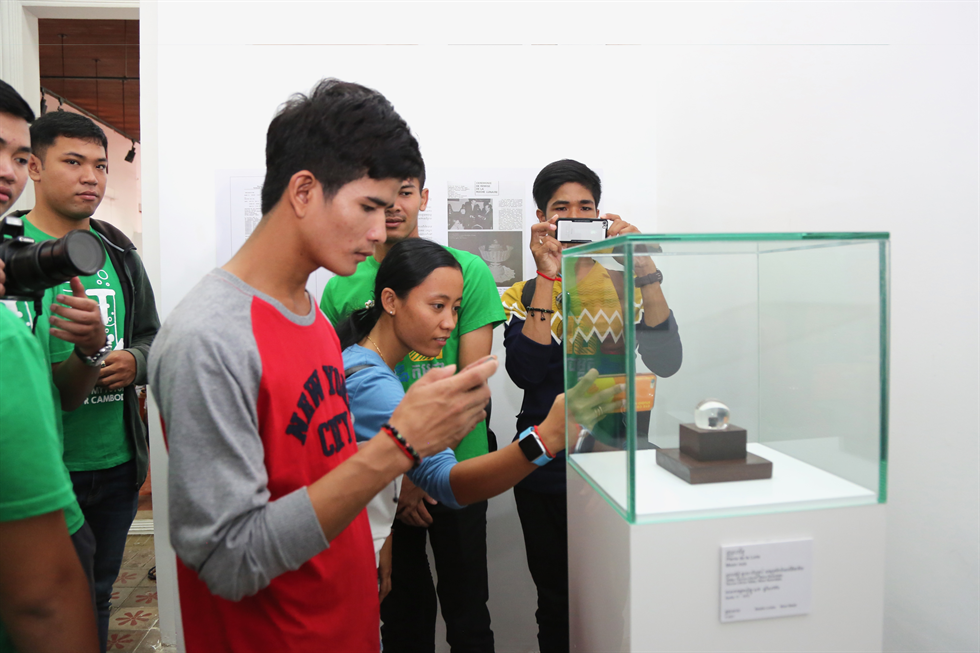Lunar mystery solved
2018-08-07
An international mystery came to a thrilling conclusion earlier this summer when a planetary scientist at NASA’s Johnson Space Center confirmed the identity of a lunar sample that had been presented to the nation of Cambodia in 1973. The sample had gone missing during years of dramatic changes in the nation’s government.
After nearly 40 years, the Moon rock resurfaced in June when a French researcher noticed an unidentified artifact in the basement of the National Museum of Cambodia. The discovery set off six months of research that later confirmed the artifact, which had been a fragment of the goodwill lunar sample from Apollo 17 that President Richard Nixon distributed to 135 nations in 1973.
What made identifying the rock challenging was that there was no background information about the history of a lunar sample at the museum, and the rock’s mount had been modified from its original setting.
With only the sample to use for identification, Dr. Ryan Zeigler, the Apollo sample curator at Johnson, was brought in to identify the rock. Zeigler and the lunar curation team used photos of the rock to link its coloring and morphology to other goodwill sample displays from the Apollo 17 mission.
“The opportunity to identify this sample and restore an amazing resource to the people of Cambodia was really special,” said Zeigler. “That rock is a symbol of the potential of human exploration, and hopefully it will inspire people from across the world to dream a little bigger.”
Zeigler’s identification of the rock achieved his goal, as the lunar sample has been restored to display and will serve as a focal point of the museum’s centennial celebration in 2020. While Cambodia is celebrating their discovery, Zeigler and the rest of the NASA Astromaterials Research and Exploration Science (ARES) team are preparing for discoveries of their own.
These discoveries will be largely based on the sample returns from the Hayabusa2 and OSIRIS-REx missions that are scheduled to return asteroid samples to Johnson in the early 2020s. As NASA’s home of extraterrestrial samples, ARES will be responsible for the curation, preservation, and initial classification of these rare samples.
NASA continues to make discoveries on this planet and others, whether it be the mysteries of the cosmos or restoring a lost treasure to a nation.
Noah Michelsohn
Johnson Space Center
After nearly 40 years, the Moon rock resurfaced in June when a French researcher noticed an unidentified artifact in the basement of the National Museum of Cambodia. The discovery set off six months of research that later confirmed the artifact, which had been a fragment of the goodwill lunar sample from Apollo 17 that President Richard Nixon distributed to 135 nations in 1973.
What made identifying the rock challenging was that there was no background information about the history of a lunar sample at the museum, and the rock’s mount had been modified from its original setting.
With only the sample to use for identification, Dr. Ryan Zeigler, the Apollo sample curator at Johnson, was brought in to identify the rock. Zeigler and the lunar curation team used photos of the rock to link its coloring and morphology to other goodwill sample displays from the Apollo 17 mission.
“The opportunity to identify this sample and restore an amazing resource to the people of Cambodia was really special,” said Zeigler. “That rock is a symbol of the potential of human exploration, and hopefully it will inspire people from across the world to dream a little bigger.”
Zeigler’s identification of the rock achieved his goal, as the lunar sample has been restored to display and will serve as a focal point of the museum’s centennial celebration in 2020. While Cambodia is celebrating their discovery, Zeigler and the rest of the NASA Astromaterials Research and Exploration Science (ARES) team are preparing for discoveries of their own.
These discoveries will be largely based on the sample returns from the Hayabusa2 and OSIRIS-REx missions that are scheduled to return asteroid samples to Johnson in the early 2020s. As NASA’s home of extraterrestrial samples, ARES will be responsible for the curation, preservation, and initial classification of these rare samples.
NASA continues to make discoveries on this planet and others, whether it be the mysteries of the cosmos or restoring a lost treasure to a nation.
Noah Michelsohn
Johnson Space Center

Charge d’Affaires Michael Newbill cuts the ribbon at the opening of the Apollo 17 goodwill moon rock exhibit at the National Museum of Cambodia.
Credit: U.S. Embassy Phnom Penh

Visitors of the National Museum of Cambodia look at the Apollo 17 goodwill sample.
Credit: U.S. Embassy Phnom Penh

Apollo 17 commander Eugene A. Cernan is holding the lower corner of the American flag during the mission's first EVA, December 12, 1972. Photograph by Harrison J. "Jack" Schmitt.
Credit: NASA







